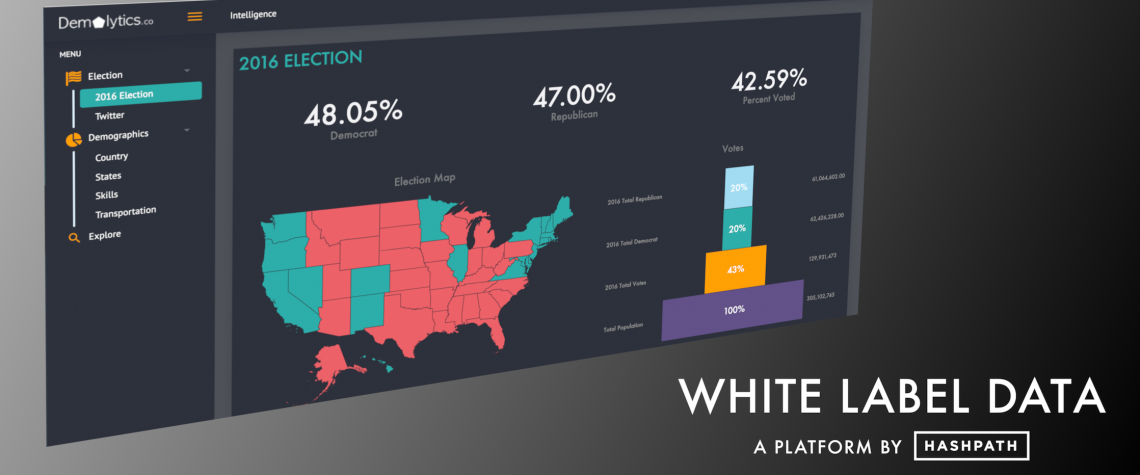Perhaps you need to keep your partners up-to-date on your business or are looking to productize your data for external clients. There are many reasons why companies need to share data. Most external data sharing today is done by sending a snapshot: an email report containing a CSV file of last month’s data, an Excel spreadsheet, or perhaps a PDF file. What data consumers really want is live data that is always updated and always current.
We’ve made major strides over the last decade with up-to-date analytics for internal users. Live dashboards are very much the norm now, thanks to data analytics platforms. But only if you have access to them, and that’s usually limited to internal users. Most companies wouldn’t consider giving an external user a direct login to their data analytics platform for a number of reasons including the user experience as well as the real potential for accidentally sharing restricted information. Instead, what’s required for live data sharing is a restricted user experience that contains carefully curated data that is well organized and easy to navigate.
White Label Data is a platform by Hashpath that lets you quickly, easily, and securely share your analytics dashboards externally.
White Label Data is a platform by Hashpath that lets you quickly, easily, and securely share your analytics dashboards externally. It’s part of Hashpath’s overall strategy of making data sharing easy. White Label Data integrates with most of the popular analytics platforms, such as Chartio, Looker, Elasticsearch, Metabase and others, to provide a secure way for third-parties to access dashboards. You can create dashboards as you do for your own internal analytics, and then share them externally. And you can do this in minutes without writing any code.
You can share live data with your external clients and partners using your own branding. You invite your own users and configure their access without the need to give them direct login credentials to your analytics platform.
Embed Your Dashboards With Simple Navigation
White Label Data makes use of iframes and integrates with your data analytics platform. You can build the dashboards directly in the data analytics platform of your choosing (or we can help you choose) and then configure that dashboard to be part of the White Label Data navigation. Once configured, the dashboard shows up in your app’s navigation tree automatically.
Here is an example of a sample Chartio dashboard that has been shared using White Label Data. It’s the same dashboard that can be viewed in Chartio, but it has been seamlessly integrated into a custom application using the White Label Data framework so that external users can see it:
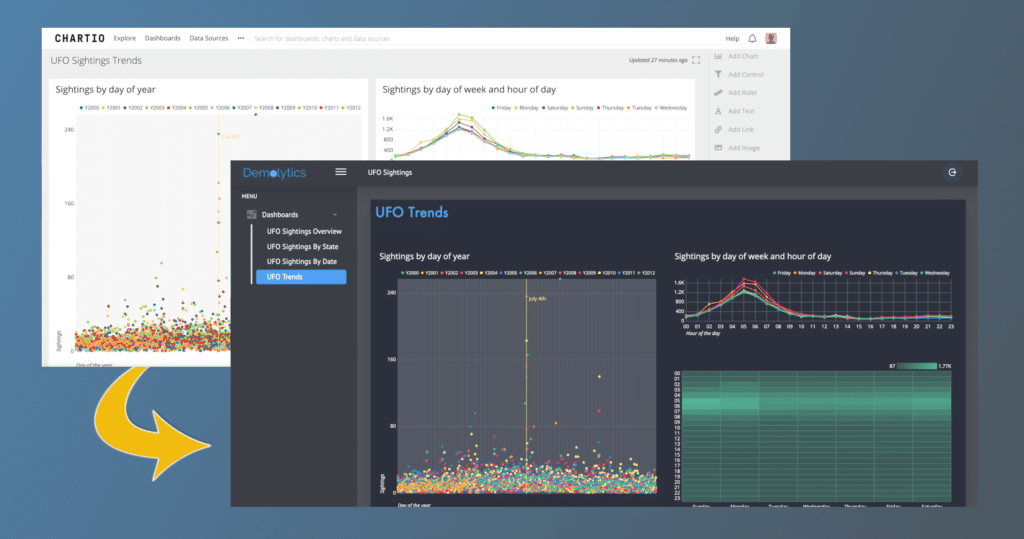
Similarly, here is a Looker dashboard as part of a White Label Data custom application. Note that the left-hand navigation contains the set of dashboards that have been shared:
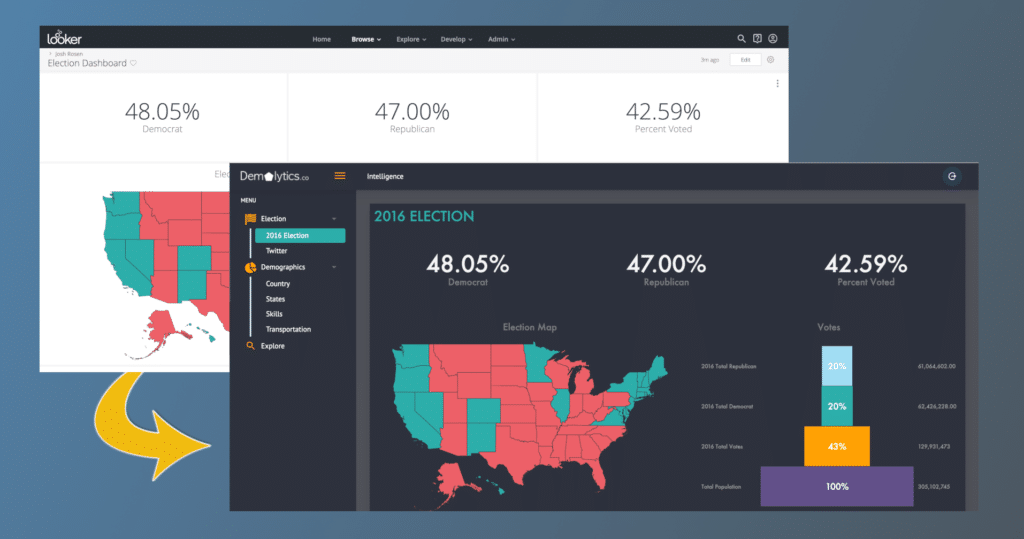
Brand Your Application
Although you are sharing your company’s data, it’s still belongs to your company and should be branded as such. White Label Data makes this possible by letting you fully brand your custom application. You can configure your company logo in the top-left corner as well as on the login page. You can also choose your colors, fonts, and icons.
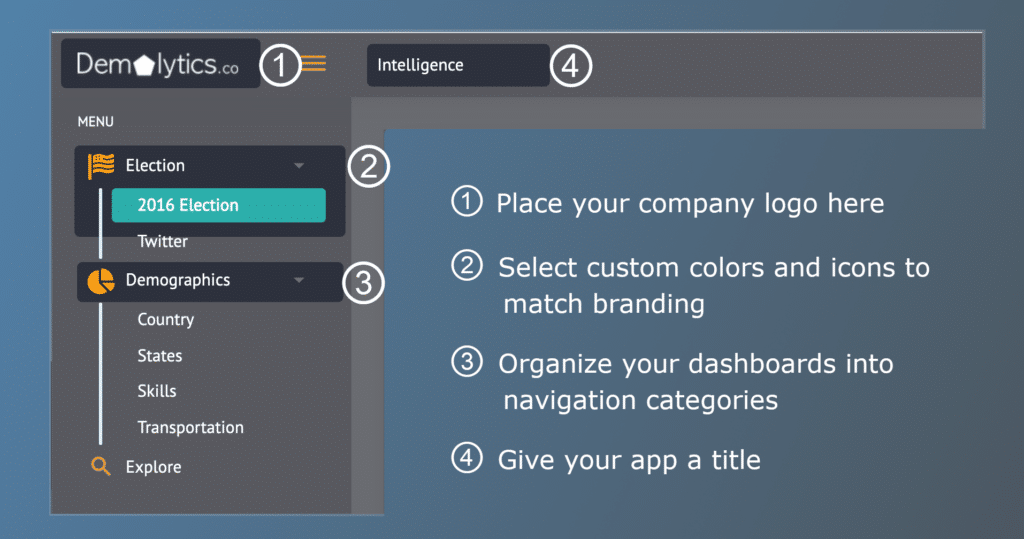
White Label Data has a built-in white/light theme and a dark theme, or you can create your own. When integrating with Looker, you can specify the Looker theme to use in the White Label Data configuration.
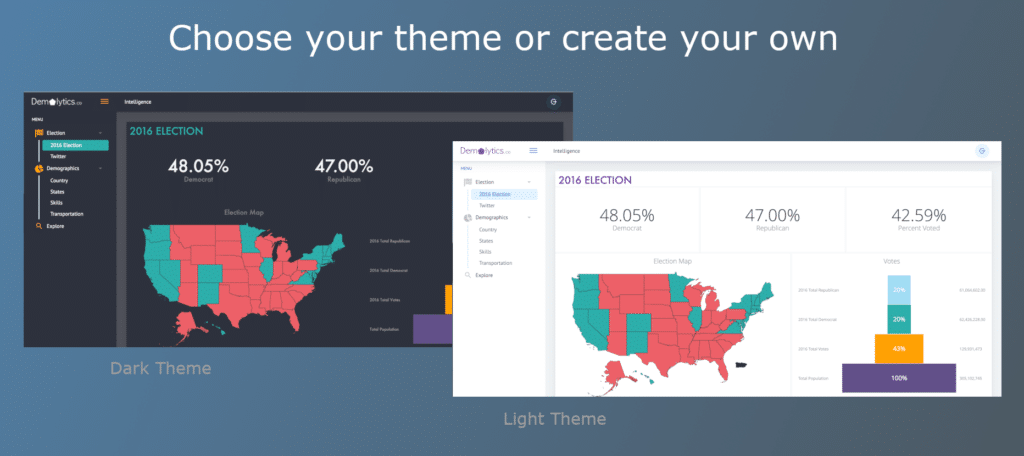
Secure Your Data and Invite Users
White Label Data applications require users to authenticate before viewing dashboards. This keeps your data secure and invite-only. After being successfully authenticated to the White Label Data application, users can view all of dashboards shared with them without having to login to the data analytics platforms directly. Under the hood, the White Label Data application generates and signs iframe URLs using secure tokens to automatically authenticate to the underlying analytics platforms.
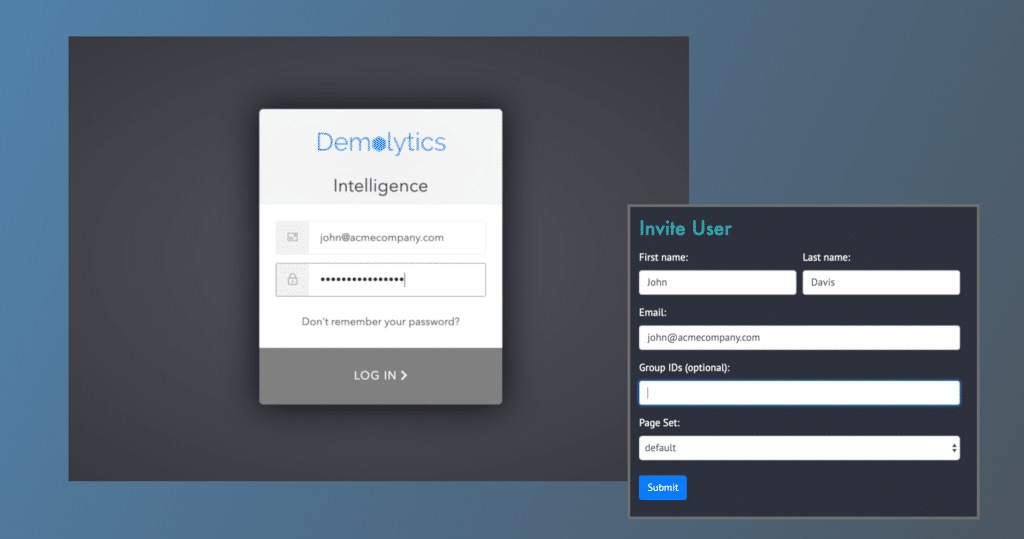
You choose who you share your data with by inviting users. White Label Data includes an Invite form that sends an invitation email to users, allowing them to create a password and securely view the shared data.
User-Specific Attributes and Filtering
Because each user must authenticate individually to White Label Data, the application is able to provide a customized user experience for each user. This is a powerful sharing feature that allows you to share different data with different consumers or partners.
White Label Data stores user attributes in each user profile. When creating and configuring the application, you can specify the set of custom attributes and whether they should be user-configurable or whether they should be specified by the admin when inviting the user. White Label Data will automatically encode these attributes in the signed URLs that are used to retrieve embedded dashboards.
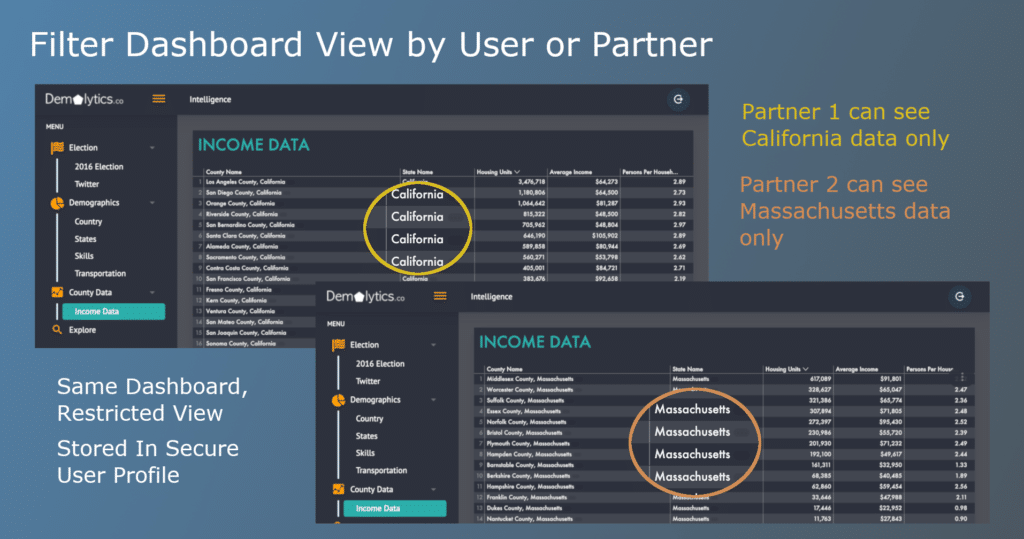
Using these user attributes, you can restrict the set of dashboards that are shared with each individual user. It is also possible to have individual dashboards show filtered data based on the currently logged in user. White Label Data integrates with the user attribute features of the respective embedded analytics platforms to make this possible. For example, when sharing Looker dashboards, White Label Data user attributes are automatically mapped to Looker user attributes and available to be used as liquid variables in LookML to control behavior and filter queries. With Chartio, White Label Data user attributes are automatically mapped to environment variables and can be used as Chartio hidden variable controls.
Filter Controls Outside the iFrame
White Label Data allow you to create drop-down filters, date filters, and text box filters that the user can interact with to filter results on the page. These filters live outside the iframe and, much like user-attributes, are encoded in the signed URLs that are used to embed dashboards. While most data analytics platforms allow you to create native controls on dashboards, the White Label Data feature allows these controls to be fully branded and styled with CSS for unlimited customization.
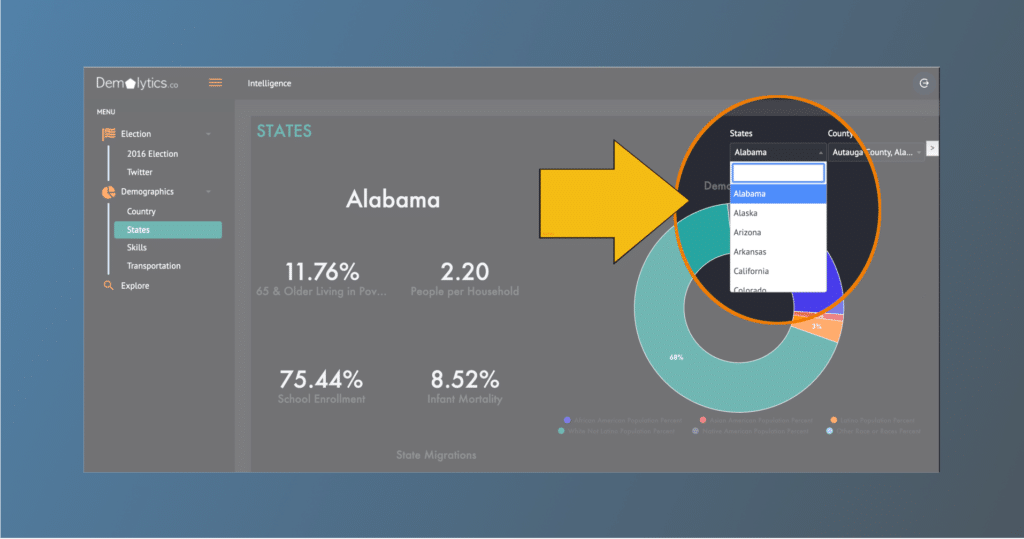
With White Label Data’s filtering controls, you have the option of specifying the set of allowed values manually or using an API (such as the Looker API) to query possible values.
URL-Based Filtering and Drill-down Links
One common use case for dashboards it to have the ability to drill down and navigate between different dashboards. For example, when clicking on a chart summarizing sales results by division, you may want to allow the user to navigate to a different page with more details about the specific division they clicked on.
White Label Data makes this possible by allowing you to specify query parameters as part of the URL and to map those to attributes that will be encoded as part of the embed URL. Those attributes in turn can be used to filter dashboards. In the case of Looker, a URL parameter (ex. https://myapp.com/mydash?division=marketing) could be mapped to a liquid variable that is then used in the WHERE clause of a derived table.
No Coding Necessary, Spin Up an App in Minutes
All configuration is specified in a JSON configuration file. You specify configuration attributes such as your application name, logo URL, page names, navigation categories, and dashboard IDs and White Label Data does the rest. There is no need to be a software developer to create an application. Share your data in minutes.
Advanced Customization Using HTML and CSS
While no coding is necessary, White Label Data also allows for more advanced customization using HTML and CSS. White Label Data has a built-in templating system (based on Django) that allows for wrapping embedded dashboards in additional HTML and CSS. For example, you could add custom titles, in-page navigation, placement of filters and modals, and additional branding.
White Label Data provides custom tags that can be used to embed dashboards. For example, to embed a Looker dashboard or look, you use the following tag:
{% addEmbed url="/embed/dashboards/123" height=”700px” width="100%" %}
or a Chartio dashboard:
{% addEmbed dashID="305475" height="700px" width="100%" %}
Under the hood, White Label Data converts these tags into complete, signed URLs containing all necessary attributes for the user and application. These tags allow for almost unlimited page customization. Combined with the ability to specify custom CSS, you have full control over the layout and appearance of pages.
Other Features
In addition to the features above, White Label Data also provides the following capabilities:
- Custom DNS Name – You can use any domain name with White Label Data. Simply point your DNS name at the White Label Data application and configure the DNS name in the configuration file.
- Free SSL Cert Included – White Label Data uses LetsEncrypt to provide free SSL certs that auto-renew.
- iFrame Loading Spinner – For iframes that take a while to load, you can enable a spinner that lets the user know the data is coming.
- Hide Header and Footer – For the times you want to hide the top and bottom of the iframe in order to make it embed more invisibly.
- Custom Looker Visualizations – Hashpath has authored a set of custom Looker visualizations. Some of those integrate with White Label Data for a better user experience.
- Looker iFrame Event Integration – White Label Data listens for iFrame postMessage events from Looker and uses these events to automatically resize iframes.
- Self-host option – Although White Label Data is usually provided as a SaaS application hosted by Hashpath, we offer you the option to license the application and run it on your own infrastructure.
If you are interested in using White Label Data or need help sharing your data, please contact us at hello@hashpath.com.

